The Preston Cook
American Eagle Collection
Learn about the eagle’s role in American history and culture from the founding of the nation to the present day.
The Preston Cook American Eagle Collection is the world’s largest single collection focused on eagles. Consisting of over 40,000 individual pieces, this unique collection of fine art, historical artifacts, and memorabilia, highlights the presence of eagles across American culture. We’ll introduce you to the collector, Preston Cook, and highlight some key items on display in the American Eagle Gallery.

Meet the Collector:
Preston Cook
For over fifty years Preston Cook has devoted his time to all things American eagle. He has amassed and meticulously organized a collection of more than 40,000 eagle objects — from kitsch to fine art, from the everyday to the rare — that reflect American life from the American Revolution to the present.
Cook has served on several government commissions and some 20 boards of directors. These include the American Bald Eagle Foundation, the Oceanic Society, and the Point Reyes Bird Observatory. He is a member of the National Eagle Center, and the Sons of the American Revolution, and is a life member of the American Bald Eagle Foundation, the American Legion, the International Federation of Fly Fishers, and Trout Unlimited.
Cook’s donated his collection to the nonprofit National Eagle Center. Proceeds from the sales of his book, American Eagle: A Visual History of Our National Emblem, are donated to the Center to help fund the museum that will house the collection. Read Preston’s Preface from the book.
A retired real estate investor, Cook lives with his wife in Wabasha, Minnesota, on the banks of the Mississippi River, a major flyway for the Bald Eagle. In addition to providing the outstanding American Eagle Collection for public enjoyment and education, Mr. Cook is an active member of the Wabasha community and long-time investor in, and partner of, the National Eagle Center.
The Collection At A Glance
Here are some highlights of the current exhibit.
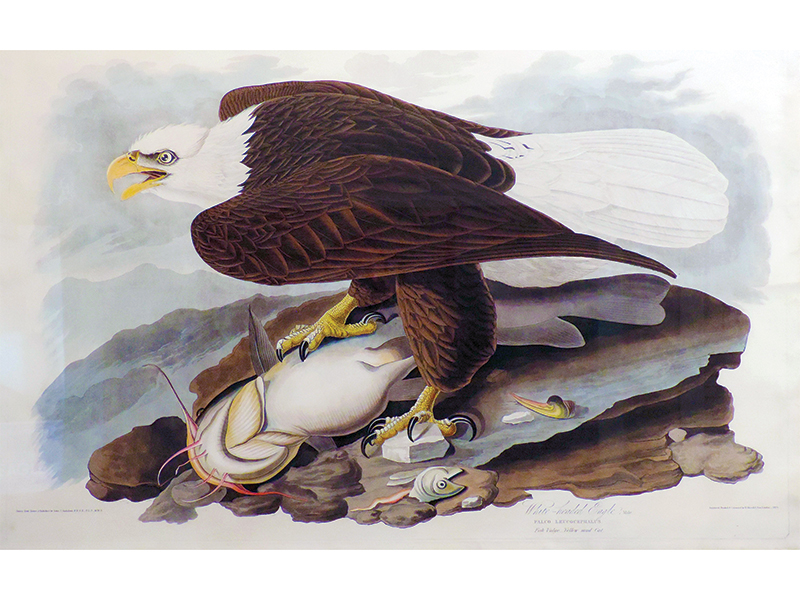
White-headed Eagle, Male, Falco Leucocephalus
Fish Vulgo – Yellow Mud Cat, 1828
Aquatint and watercolor
(John James Audubon, American, April 26, 1785 – January 27, 1851)
(Robert Havell, Jr., engraver, London, 1828)
This engraving is Plate 31 in John James Audubon’s Birds of America, first published in London, in an extra-large format called a double elephant folio. Robert Havell and his son, Robert Jr. engraved and printed the work from 1827 to 1838, using the aquatint process to create superior illustrations that were then hand colored. Falco leucocephalus was the Linnaean term for the Bald Eagle at that time; in 1897, the Bald Eagle was reclassified to the genus Haliaeetus.
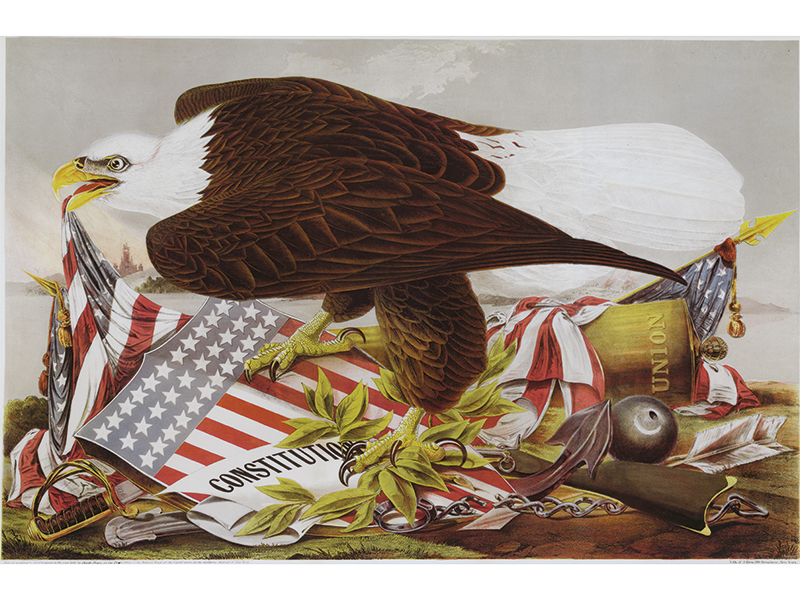
Bien Edition of the Constitution/Union Eagle
Digital print
(John James Audubon)
German born, new United States citizen, Julius Bien, showed his American patriotism in this version of the White-headed Eagle early in the Civil War.
Important symbolism of note in this work include the American flag, the Constitution, the Union shield, broken chains, swords, and cannon balls all illustrating the Union perspective of the Civil War.
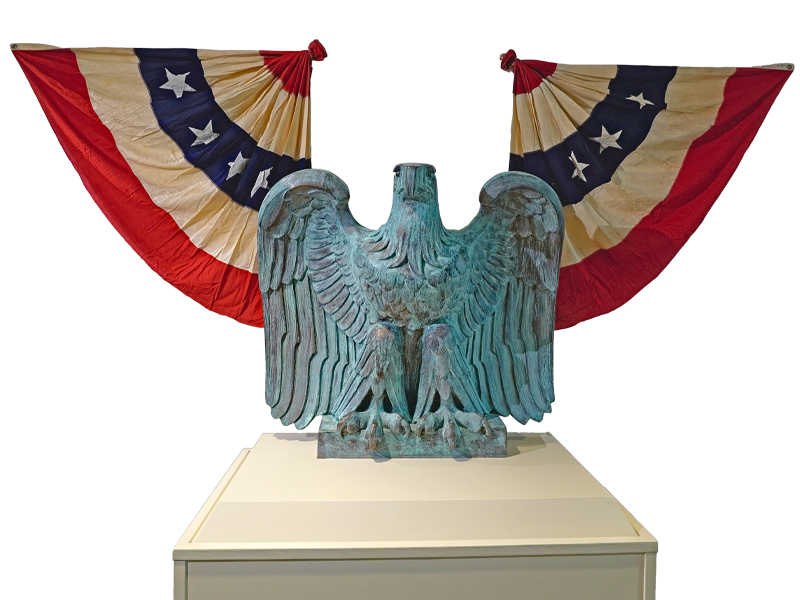
FDR Eagle Statue and Bunting,
Presidential Inauguration Eagle Ornament, 1941
(Artist Unknown)
This eagle decorated the viewing stand in front of the White House for President Franklin D. Roosevelt’s third inauguration in 1941. Both the eagle and the bunting are the actual decorations used during the inaugural.
The Great Seal
Aluminum
This Great Seal hung in a courtroom in the John W. McCormack Building in Boston, Massachusetts until its removal in 2006 for a building renovation. John W. McCormack was a member of the House of Representatives and Speaker of the House from 1962 to 1971.
Congress adopted The Great Seal of the United States in 1782. Several revisions have been issued, the most recent in 1972. The United States Secretary of State is responsible for the Great Seal. In the Department of State, the term “Great Seal” refers to a physical mechanism which is used by the Department to affix the seal to official government documents. This mechanism includes not only the die (metal engraved with a raised inverse image of the seal), but also the counterdie, the press and cabinet in which it is housed.
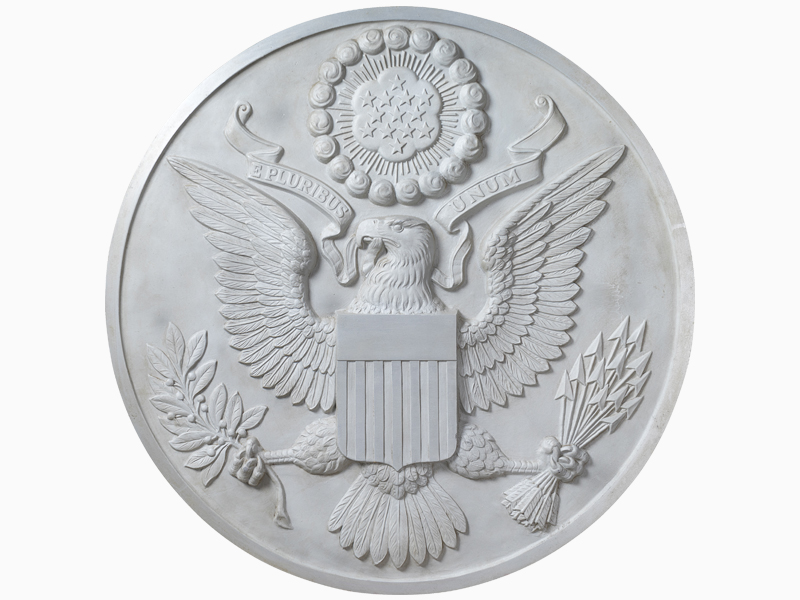
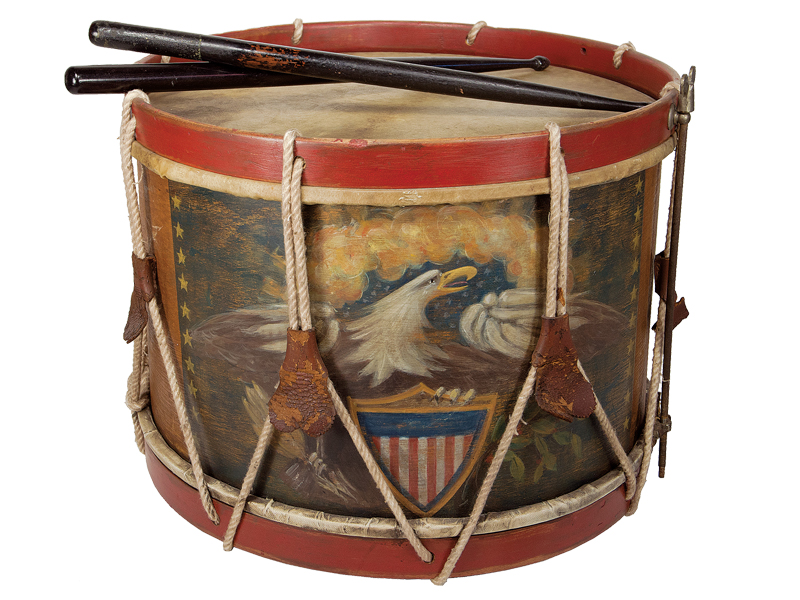
Civil War Drum
H.R.W. Eisenbrandt (American)
H.R.W. Eisenbrandt took over the family musical instrument business from his father, who died just before the American Civil War began. Their factory in Baltimore, Maryland was known for producing wood-wind instruments, drums, and horns between 1811 and 1949.
This drum was used by the Union Army showing the eagle as a symbol of the United States.
Aquila, 2022
Paper, metal
Bonnie (Bebe) Kuhr (American)
Altered books are a mixed media art form that changes a book from its original form into something different. The transformation may affect the appearance and/or meaning of the book. Various methods are employed to create altered books including, but not limited to, cutting, tearing, shredding, folding papers, and embedding materials or items into the book itself.
In this case, the artist set out to transform the pages and plates from the book, American Eagle: A Visual History of Our National Emblem, by Preston Cook, into a work of art. Perforated aluminum was cut into the shape and size of an eagle’s wing that was used as the structure of the sculpture. The artist then hand-formed the metal into the wing structure and selected colored pages from the book based on their palette and pixels, cut them into narrow strips, and wove them into the form to complete the transformation of the wing.
The piece incorporates the imagery of an 1858 United States flag that signifies when Minnesota became the 32nd state to join the Union. The result is a multi-sensory experience for the viewer and to highlight the significance of the eagle as our national emblem.
This one-of-a-kind piece is unique to the Preston Cook American Eagle Collection.
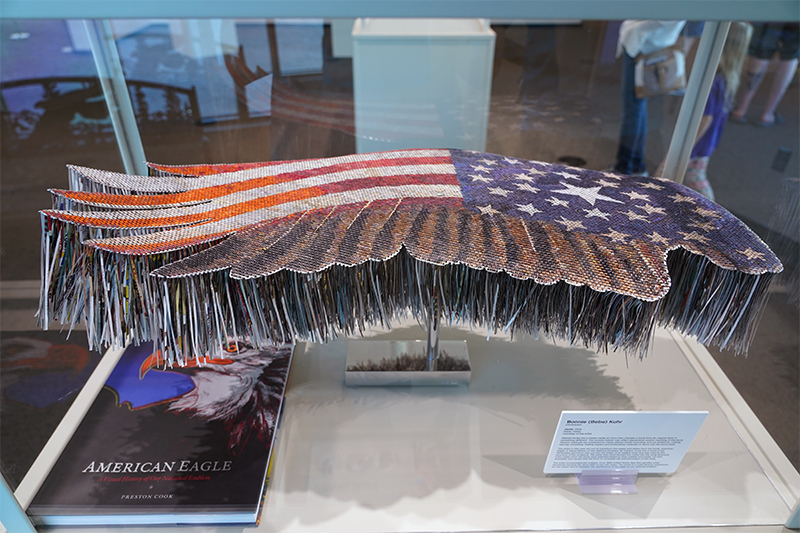
Read About Bald Eagles in American Culture
Breathtaking images and rich history

American Eagle: A Visual History of Our National Emblem by Preston Cook
American Eagle: A Visual History of Our National Emblem explores the eagle in American life through a vast array of objects and memorabilia in virtually every shape, size, and medium that comprises the Preston Cook American Eagle Collection.
The Cook Collection has been donated to and is being exhibited at the newly renovated National Eagle Center. The Cook Collections consists of almost 40,000 pieces of exquisite artwork, photographs, and illustrations; a 1,500 item library; military and political ephemera, and everyday and unique memorabilia dating from the American Revolution to the present.
Help Conserve a National Treasure
Donate to the National Eagle Center today so that people can continue to admire these birds for many more tomorrows.
Become a Member
Get exclusive discounts on many eagle adventures and support the protection of eagles everywhere.
